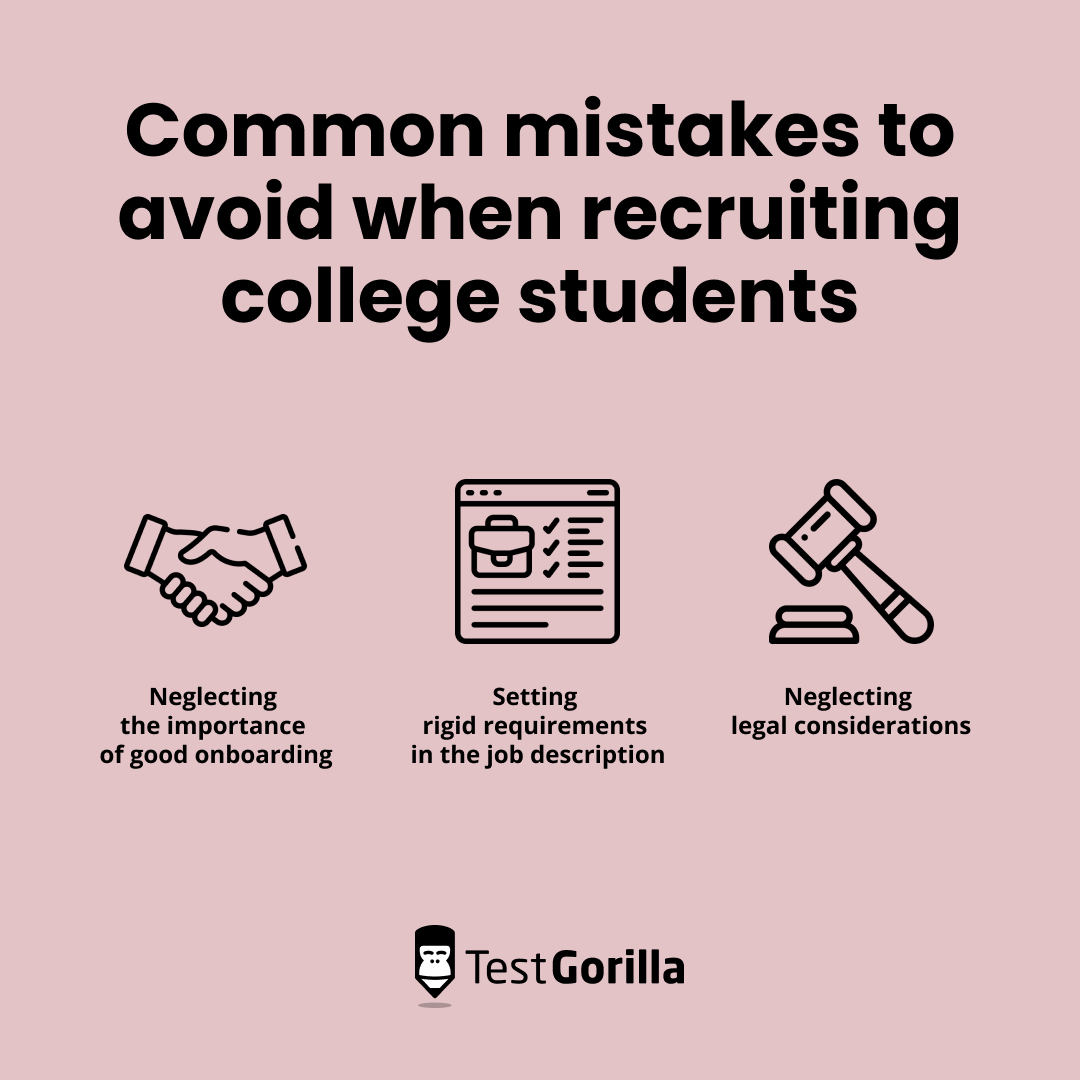Hiring college students can be a great way to bring in fresh talent at lower costs while giving students much-needed job experience.
Unfortunately, recruiters don’t always know how to best appeal to and interact with today’s generation of primarily Gen Z students. Moreover, they don’t know how to assess candidates without degrees or much work experience. And a mis-hire can disrupt team dynamics, make critical mistakes, and damage your reputation.
The legalities of hiring college students are also tricky, and legal missteps can result in penalties – including hefty fines.
In this guide, we help you understand how to find and attract the best college students efficiently and legally. We also discuss which skills to look for and how to assess them – so you can recruit top-tier students.
Table of contents
- Why do companies recruit college students?
- Skills to look for in college students
- Where to find top college students
- Top tips to attract college students
- How to select and assess college students
- Common mistakes to avoid when recruiting college students
- Legal considerations for hiring college students
- Recruit college students who thrive with TestGorilla
Why do companies recruit college students?
Here are some of the benefits of hiring college students.
Fresh perspective: Students often know the latest trends, technologies, and methods – bringing innovation, efficiency, and new ideas to your company.
Eagerness to learn: Good students go above and beyond to learn and grow. They tend to adapt quickly to new environments, making it easier for you to train and mold their skillset.
Tech-savvy skills: Many college students are tech-savvy, making them well-suited to roles involving the use of software, social media, and other digital platforms.
Adaptability and flexibility: Students are typically more flexible in their approach to work. They’re often willing to take on multiple tasks or pivot roles as needed.
Cost-effective: Hiring students as interns or part-time workers can be cheap since they’re more likely to work for lower rates than experienced professionals. Some college students also accept unpaid internships in exchange for college credit or as part of their degree requirement.
Long-term talent pipeline: Investing in students early on might make it easy to bring them on as permanent employees when they graduate – saving you hassle, time, and money.
Enhanced social media presence: Students are usually active on social platforms and could boost your company’s social media presence by posting about their experiences and providing testimonials.
Skills to look for in college students
College students have had less work experience and skills development opportunities than other candidates. Here are some fundamental skills and qualities to look for in the best candidates.
Hard skills
Industry-specific knowledge: Roles in healthcare, law, and other specialized areas might require industry-specific knowledge. For example, a medical intern must have foundational knowledge in subjects like biology, anatomy, medical terminology, and healthcare regulations to work in the field.
Technical competence: For tech-based roles, students must have basic skills in programming languages, software development, and so on.
Analytical skills: Most roles require the ability to work with data, analyze trends, and make data-driven decisions. Candidates should also be familiar with key tools like Microsoft Excel and Google Sheets.
Numerical reasoning: Look for candidates who can work with numbers and interpret data in the forms of graphs and charts – skills used widely across industries.
Communication, verbal reasoning, and reading comprehension: The ability to communicate clearly and effectively – in both verbal and written formats – and accurately read and interpret information is crucial to success in almost any role.
Soft skills
Teamwork: The best candidates can work well with others and contribute positively to team goals.
Adaptability: Look for candidates open to learning quickly and adjusting to new environments and tasks.
Time management: The ability to prioritize tasks and meet deadlines is essential in roles where students work with multiple stakeholders and teams simultaneously.
Problem-solving: Seek candidates who can identify problems proactively and propose effective and innovative solutions.
Work ethic: Good candidates will have demonstrated a strong work ethic through academics, internships, or extra-curricular activities.
Where to find top college students
Here are some ways to source the best college students.
Internship and apprenticeship programs
Consider creating an internship program. You might partner with colleges to do this, giving students the opportunity to earn college credit through work with your company and supplement their internships with relevant coursework.
Internships are usually short-term opportunities where students can gain practical work experience in a specific industry. These can be either paid or unpaid.
College partnerships
Consider collaborating directly with universities and colleges for purposes beyond internships. You can offer workshops and guest lectures, sponsor student events, participate in campus recruitment fairs, and work with career departments to build your employer brand and access potential candidates.
Job boards
Post open roles to public job boards like College Recruiter to find college and university students looking for internships, freelancing opportunities, and more. Some colleges even have their own job boards, enabling you to target students from specific schools.
Social media
Use social platforms like TikTok and Instagram to engage with students. Share behind-the-scenes glimpses, student success stories, and internship opportunities to attract today’s generation and build your employer brand.
Alumni networks
Tap into your alumni from your existing employee base. They often maintain connections with their alma mater and can help you reach out to students for job opportunities.
Hackathons and other competitions
Sponsor hackathons or other skills-based competitions to spot and recruit top talent while showcasing your company’s culture.
Top tips to attract college students
Recruiting college students is different from hiring experienced professionals. Use the strategies below to create an appealing campaign and attract the best students.
Establish a strong and relatable employer brand
Use your job description and social media advertisements to highlight your company’s culture and values and showcase what makes your company a great place for young talent.
For instance, emphasize any sustainability, social responsibility, or diversity and inclusion initiatives your company engages in. This resonates with many of today’s Gen Z students who feel strongly about these topics.
Tailor the offer to align with students’ needs
Think about what’s important to students and ensure your job offer reflects this. For instance, offering remote or hybrid work possibilities can be a huge draw for students seeking a balance between work, academics, and personal commitments.
Show them how your company would enable their professional growth. Discuss workshops, certifications, mentoring, and other development initiatives they’d have access to during their time with your company.
Finally, this generation of students cares about doing meaningful work. Showcase how their roles will contribute to the organization’s mission and future success.
Use campus ambassadors
Choose student ambassadors who can represent your company in your top-choice colleges. These ambassadors act as liaisons between you and the student body. They assist in recruitment efforts, create content for social media and blogs, and facilitate engagement through events and workshops.
You can find college ambassadors through partnerships with college careers centers or by posting the role on job boards or social media. You should usually offer them monetary incentives like commissions or stipends. However, some campus ambassadors may be open to non-monetary incentives, including access to development initiatives or company discounts.
How to select and assess college students
College students don’t usually have long and strong resumes, and even if they do, there’s no way to verify their skills.
he best way to select and assess college students is with a talent assessment platform like TestGorilla. It’s quick and gives you an objective way to measure students’ strengths and development areas.
Here are some talent assessments you might use to assess students’ capabilities.
TestGorilla’s Microsoft Excel and Google tests check for basic proficiency with these key data analysis tools.
The Microsoft PowerPoint and Google Slides assessments evaluate students’ abilities to create impactful presentations for internal and external use.
Our TikTok marketing and social media management assessments are useful for students who’ve applied for social media marketing roles.
Coding entry levels algorithms and programming tests evaluate students’ coding fundamentals.
TestGorilla’s verbal reasoning, numerical reasoning, critical thinking, problem-solving, and other cognitive ability tests assess students’ aptitudes to perform well in various roles.
Our 16-types test and other personality and culture assessments ensure each candidate is a good fit for your company.
Common mistakes to avoid when recruiting college students
Look out for these common pitfalls when hiring college students.
Neglecting the importance of good onboarding
College students may require additional support when entering the workforce for the first time. A bad onboarding experience could set them up for failure, which might damage your employer brand and deter other students from applying in the future.
Use talent assessments to identify areas for improvement and provide college hires with support through the onboarding process. For instance, a student might have all the right technical skills but needs to work on their customer communication skills. So, assign them a mentor or buddy to help them through this.
Setting rigid requirements in the job description
Don’t forget that in most cases, college students aren’t highly experienced or skilled. Adding too many qualifications and rigid requirements to your role descriptions may overwhelm and deter students from applying for the role.
So focus on basic technical and soft skills and explain how you’ll aid students’ professional development during their time at your company.
Neglecting legal considerations
Carefully understand which laws apply to recruiting and hiring college students. Ignoring legal considerations can put you at risk of breaking laws and facing penalties.
Legal considerations for hiring college students
When attracting and hiring college students, be aware of your legal considerations. Some are below.
Paid versus unpaid internships
While some primarily educational internships can be unpaid, don’t assume all can. You must meet specific guidelines set by the Fair Labor Standards Act to create unpaid internships. For example, the role should be focused primarily on providing students with a learning experience rather than on benefits to your company.
Child labor
While most college students will be of age, minors are subject to child labor laws, setting limitations on the types of work, hours of work, and conditions for students under a certain age. Some 16 and 17-year-olds won’t be allowed to work in certain “hazardous” conditions, for example.
Age discrimination
Specifically targeting college students with your internship programs is generally acceptable, as many internships are designed to supplement a student’s college learning. This means employers can require an intern to be enrolled at a college as a condition of the internship.
Regular employment, however, is different. The Age Discrimination in Employment Act prohibits discrimination against individuals 40 years of age or older in hiring practices. So, you must ensure your recruitment methods and materials aren’t age discriminatory.
Here’s a cautionary tale: in 2016, a group of workers over 40 sued one company for excluding them by recruiting exclusively on college campuses for its entry-level positions and not posting those same positions on its careers page. In addition to paying $11.6 million, the company agreed to change its recruiting practices to settle the lawsuit.
Recruit college students who thrive with TestGorilla
College hires can greatly benefit your company – just be sure to use the right recruitment methods and seek out strong candidates. College job boards, career fairs, and social media platforms are great places to recruit college students. And talent assessments can evaluate their capabilities quickly and effectively.
Want to learn more about how TestGorilla’s talent assessments can enable you to help skilled students enter the workforce?
Register for a free TestGorilla plan, schedule a free 30-minute live demo, or take a product tour to get started today.
Related posts
Hire the best candidates with TestGorilla
Create pre-employment assessments in minutes to screen candidates, save time, and hire the best talent.
Latest posts
The best advice in pre-employment testing, in your inbox.
No spam. Unsubscribe at any time.

Hire the best. No bias. No stress.
Our screening tests identify the best candidates and make your hiring decisions faster, easier, and bias-free.
Free resources
This checklist covers key features you should look for when choosing a skills testing platform
This resource will help you develop an onboarding checklist for new hires.
How to assess your candidates' attention to detail.
Learn how to get human resources certified through HRCI or SHRM.
Learn how you can improve the level of talent at your company.
Learn how CapitalT reduced hiring bias with online skills assessments.
Learn how to make the resume process more efficient and more effective.
Improve your hiring strategy with these 7 critical recruitment metrics.
Learn how Sukhi decreased time spent reviewing resumes by 83%!
Hire more efficiently with these hacks that 99% of recruiters aren't using.
Make a business case for diversity and inclusion initiatives with this data.


















